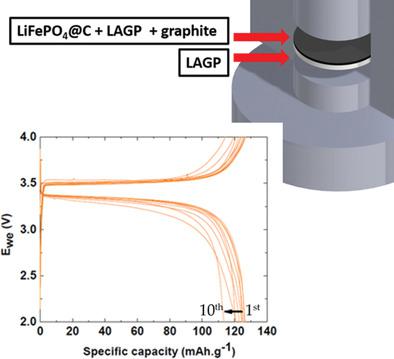当前位置:
X-MOL 学术
›
Adv. Mater. Interfaces
›
论文详情
Our official English website, www.x-mol.net, welcomes your
feedback! (Note: you will need to create a separate account there.)
Toward an All‐Ceramic Cathode–Electrolyte Interface with Low‐Temperature Pressed NASICON Li1.5Al0.5Ge1.5(PO4)3 Electrolyte
Advanced Materials Interfaces ( IF 4.3 ) Pub Date : 2020-05-04 , DOI: 10.1002/admi.202000164 Andrea Paolella 1 , Wen Zhu 1 , Giovanni Bertoni 2, 3 , Alexis Perea 1 , Hendrix Demers 1 , Sylvio Savoie 1 , Gabriel Girard 1 , Nicolas Delaporte 1 , Abdelbast Guerfi 1 , Matthias Rumpel 4 , Henning Lorrmann 4 , George P. Demopoulos 5 , Karim Zaghib 1
Advanced Materials Interfaces ( IF 4.3 ) Pub Date : 2020-05-04 , DOI: 10.1002/admi.202000164 Andrea Paolella 1 , Wen Zhu 1 , Giovanni Bertoni 2, 3 , Alexis Perea 1 , Hendrix Demers 1 , Sylvio Savoie 1 , Gabriel Girard 1 , Nicolas Delaporte 1 , Abdelbast Guerfi 1 , Matthias Rumpel 4 , Henning Lorrmann 4 , George P. Demopoulos 5 , Karim Zaghib 1
Affiliation

|
This work shows, for the first time, the critical influence of pressure during the hot sintering stage on the ionic conductivity of the lithium super ionic conductor Li1.5Al0.5Ge1.5(PO4)3. A hot press method is developed to obtain high ionic conductivities at the significantly decreased densification temperature of only 650 °C by applying pressure (56 MPa). Considering the possible initiation of undesirable decomposition reactions when cathode materials are annealed at high temperature (typically ≥700 °C), the use of high pressure at 650 °C can significantly limit the formation of degradation by‐products. This study determines the criteria required to optimize the pressure and temperature parameters for enhancing the total ionic conductivity. Finally, this study reports an all solid‐state battery based on a LiFePO4 olivine cathode prepared at 650 °C showing very good Li‐intercalation/deintercalation performance. Good ionic interfacial contact is achieved without using polymer and liquid electrolyte.
中文翻译:

迈向具有低温加压NASICON Li1.5Al0.5Ge1.5(PO4)3电解质的全陶瓷阴极-电解质界面
这项工作首次显示了热烧结阶段压力对锂超离子导体Li 1.5 Al 0.5 Ge 1.5(PO 4)3的离子电导率的关键影响。。开发了一种热压法,通过施加压力(56 MPa)在仅650°C的显着降低的致密化温度下获得高离子电导率。考虑到阴极材料在高温(通常≥700°C)下退火时可能会引发不良的分解反应,因此在650°C下使用高压会大大限制降解副产物的形成。这项研究确定了优化压力和温度参数以提高总离子电导率所需的标准。最后,本研究报告了基于LiFePO 4的全固态电池在650°C下制备的橄榄石阴极显示出非常好的Li嵌入/去嵌入性能。无需使用聚合物和液体电解质即可实现良好的离子界面接触。
更新日期:2020-05-04
中文翻译:

迈向具有低温加压NASICON Li1.5Al0.5Ge1.5(PO4)3电解质的全陶瓷阴极-电解质界面
这项工作首次显示了热烧结阶段压力对锂超离子导体Li 1.5 Al 0.5 Ge 1.5(PO 4)3的离子电导率的关键影响。。开发了一种热压法,通过施加压力(56 MPa)在仅650°C的显着降低的致密化温度下获得高离子电导率。考虑到阴极材料在高温(通常≥700°C)下退火时可能会引发不良的分解反应,因此在650°C下使用高压会大大限制降解副产物的形成。这项研究确定了优化压力和温度参数以提高总离子电导率所需的标准。最后,本研究报告了基于LiFePO 4的全固态电池在650°C下制备的橄榄石阴极显示出非常好的Li嵌入/去嵌入性能。无需使用聚合物和液体电解质即可实现良好的离子界面接触。











































 京公网安备 11010802027423号
京公网安备 11010802027423号